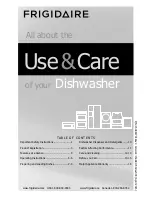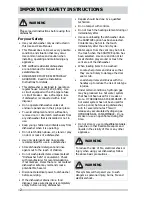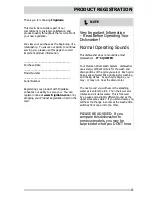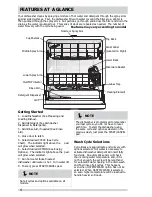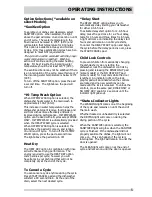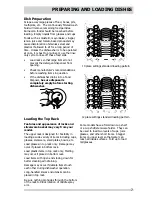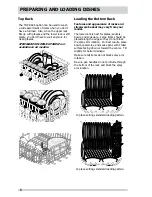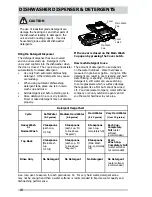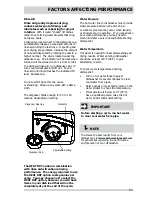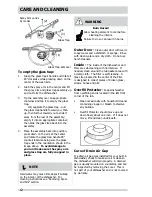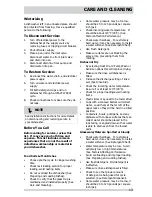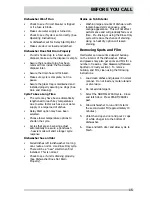
14
BEFORE YOU CALL
Dishware Chipped
•
Load with care and do not overload. (See
Preparing and Loading Dishes).
•
Place delicate items in top rack.
•
Place glasses securely against pins and
not over pins.
•
Load items so they are secure and don’t
jar loose when moving racks in and out.
Move racks in and out slowly.
•
Make sure tall glasses and stemware will
clear top of tub when rack is pushed in.
•
Fine antique china and crystal should be
hand-washed.
Dishware Stained or Discolored
•
Tea and coffee can stain cups. Remove
the stains by hand washing in a solution
of 1/2 cup (120 ml) bleach and one quart
(1L) of warm water. Rinse thoroughly.
•
Iron deposits in water can cause a yellow
or br
own fi lm. A special fi lter installed
in the water supply line will correct this
problem. (See Removing Spots and Film).
•
Aluminum utensils can leave gray/black
marks when they rub against other items.
Load Properly.
•
Certain high acid foods can cause
discoloration of stainless steel and plastics
if allowed to sit for a long period. Use the
Rinse Only cycle or rinse by hand if not
operating dishwasher at once.
•
Mixing stainless steel and silver utensils
in silverware basket can cause pitting of
the stainless steel blades. Avoid mixing
stainelss steel and silver.
Etching
•
Using too much detergent especially in
soft or softened water causes damage
that looks like a fi lm but cannot be
removed.
•
Adjust the amount of detergent based
on the water hardness. (Check Detergent
Chart).
•
Lower the water temperature by selecting
the Normal Cycle.
Detergent Left in Cups
•
Detergent may be old. Discard and use
fresh detergent.
•
Be sure the dish load doesn’t spray from
entering the detergent cup.
•
Chcek to see if cycle has been completed.
•
Make sure items do not prevent the
detergent dispenser from opening.
Vapor at Vent
•
Water vapor escapes fromt he vent during
the drying part of cycle. This is normal.
•
Spilled rinse aid can cause foam and lead
to overfl owing. Wipe up any spills with a
damp cloth.
•
Check to see that dishwasher is level.
(See Installation Instructions).
Normal Sounds You Will Hear
•
Normal sounds include water fi ll, water
circulation and motor sounds.
•
There is a noticeable change in sound
when the wash action switches between
the lower and middle spray arm. This is
normal since each spray arm has it’s own
sound.
•
It is normal for the dishwasher to pause
(no sound) when the wash action is
switching between the lower and middle
spray arms.
Water in Bottom of Tub
•
Water left in the tub bottom after the
cycle is complete is not normal. If
water remains in the bottom of the tub,
the dishwasher may not be draining
properly. (See Dishwasher Does not Drain
Properly).
Dishwasher Leaks
•
Check that the door gasket is pressed
into its mounting channel, reaches to the
bottom of the tub and does not extend
beyond the end rib so as to interfere with
door closure.
•
Spilled rinse aide can cause foam and
lead to overfl owing. Wipe up any spills
with a damp cloth.
•
Check to see that the dishwasher is level.
(See Installation Instructions).
•
Avoid oversudsing by using the correct
amount of detergent designed for
automatic dishwashers.
•
Check to see that dishwasher is level.
(See Installation Instructions).
Dishwasher Won’t Fill
•
Assure the water supply is turned on.
•
Check that the overfi ll protector moves up
and down freely. (See Overfi ll Protector
section).

